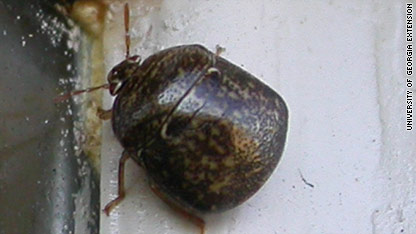Guide to NC Pests
|
Kudzu Bugs
Kudzu bugs have several generations of offspring per year. In the spring, they feed extensively in kudzu patches and on other legume hosts. In July-August, they will move into soybeans where they feed on stems and foliage and can have a significant impact on crop yields. The bugs continue to feed and lay eggs into the fall on kudzu and other hosts. As temperatures and day length decline, kudzu bugs seek out sheltered areas where they can pass the winter, such as under bark or rocks, or in leaf litter, etc. As they encroach on kudzu patches and soybean fields near residential areas, we can expect to see them invade homes similar to the behavior of another nuisance pest - the Asian lady beetle. The bugs will often congregate on light-colored surfaces (such as siding, fascia boards, etc.) as seen in the picture above. They will then move under siding, or into gaps around doors and windows, or through penetrations such as around air conditioning and water pipes. In the following spring, the bugs become active again and begin moving onto kudzu and other host plants. As a result, those bugs which have overwintered inside homes (inside walls, attics, etc.) may end up inside the home instead of heading to food sources. |

 Kudzu
bugs are 4 to 6 mm long (about 1/6" - 1/4"), somewhat
oblong in shape, and olive-green colored with brown
speckles (see picture at right). They are "true bugs"
and so they have piercing-sucking mouthparts. Aside from
kudzu, these insects are known to feed on a wide variety
of plants such as soybeans and other bean species, as
well as wisteria and some types of local flowers and
vines.
Kudzu
bugs are 4 to 6 mm long (about 1/6" - 1/4"), somewhat
oblong in shape, and olive-green colored with brown
speckles (see picture at right). They are "true bugs"
and so they have piercing-sucking mouthparts. Aside from
kudzu, these insects are known to feed on a wide variety
of plants such as soybeans and other bean species, as
well as wisteria and some types of local flowers and
vines.